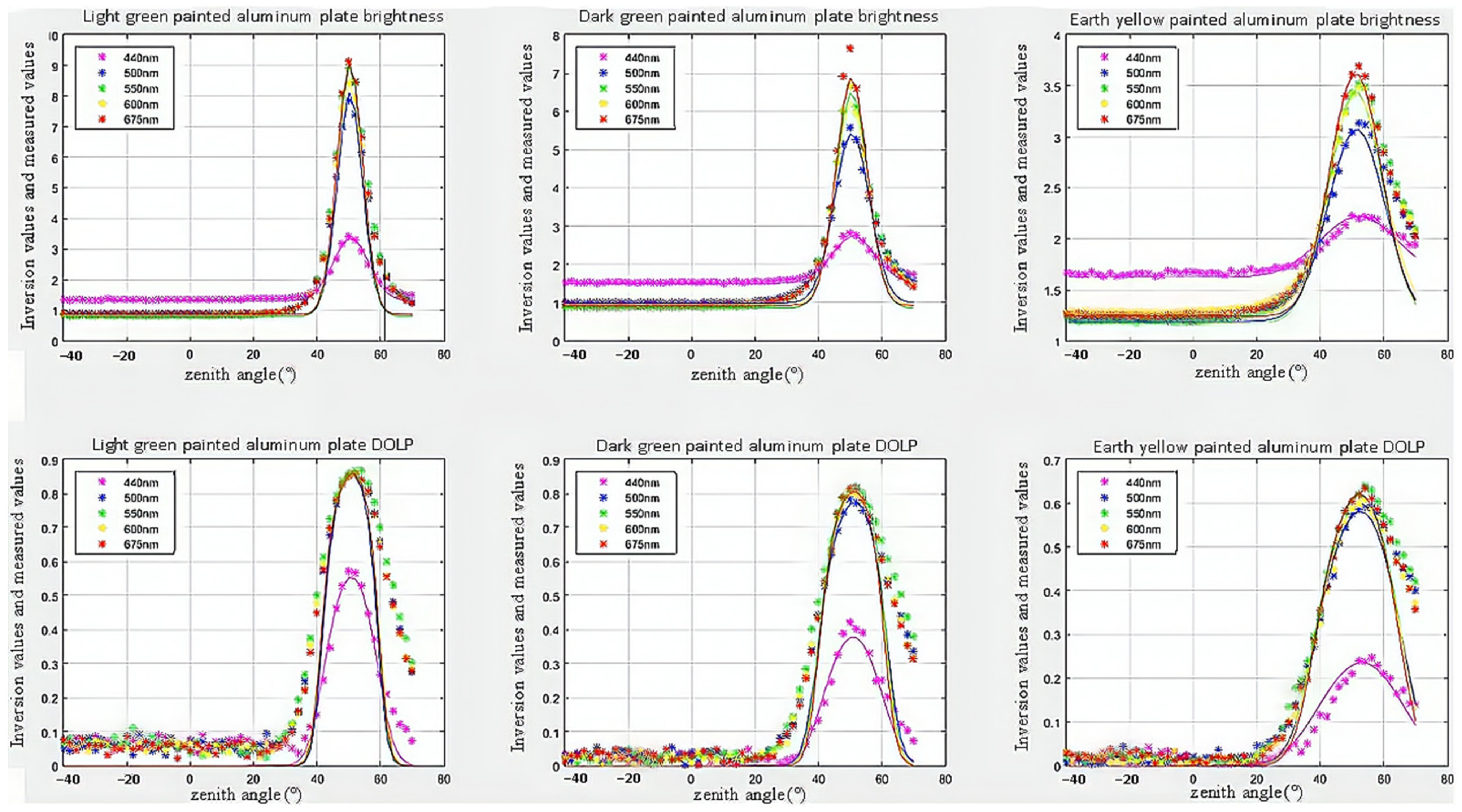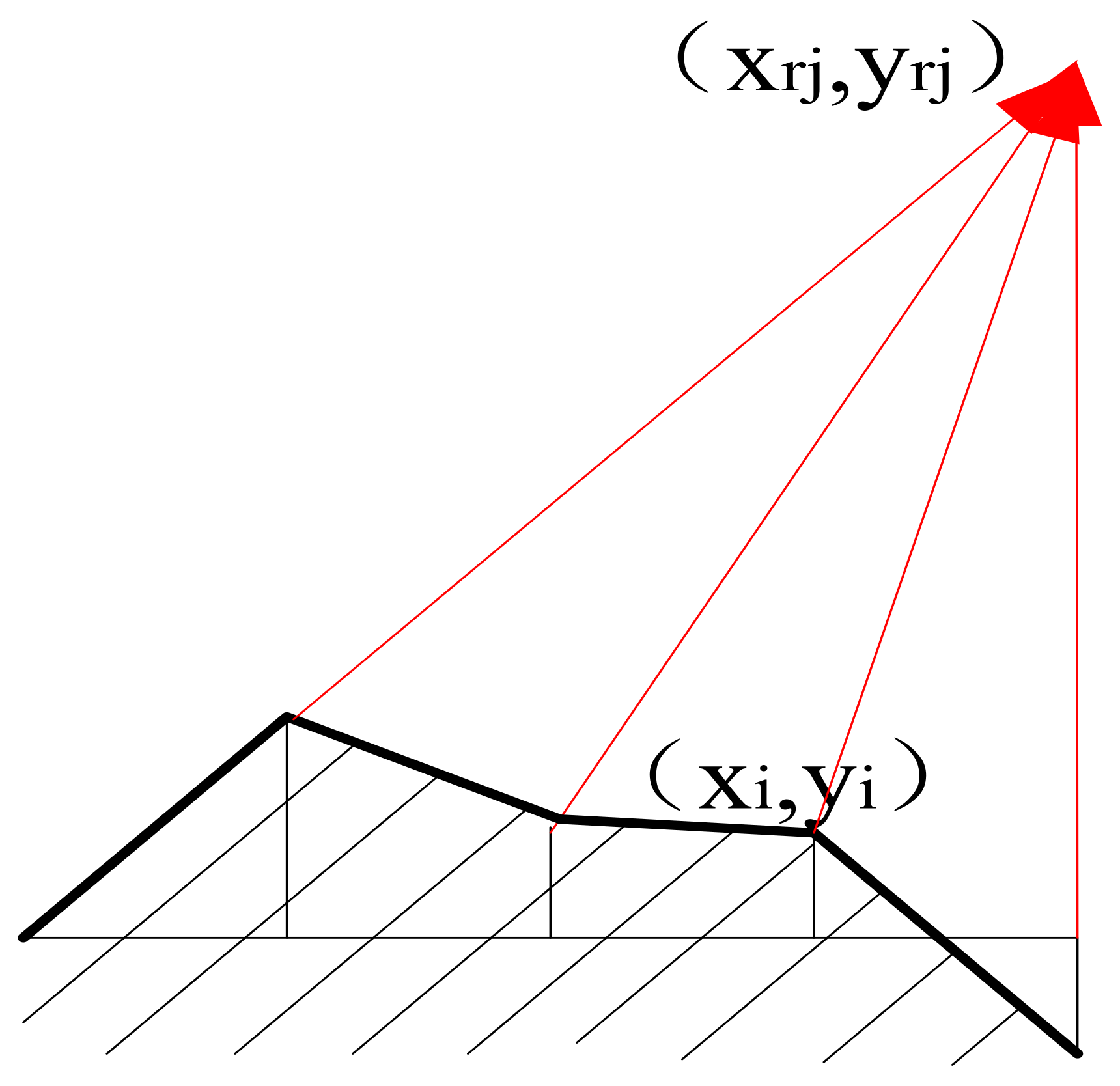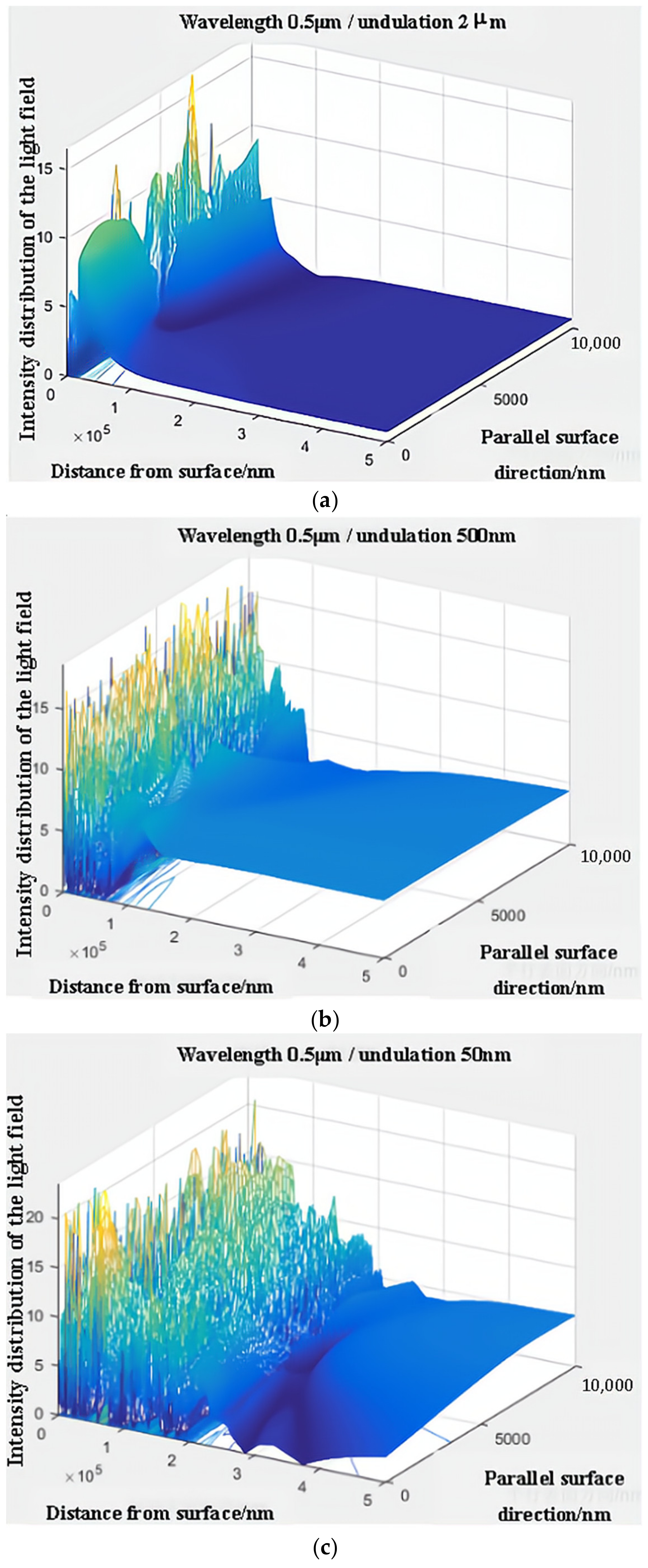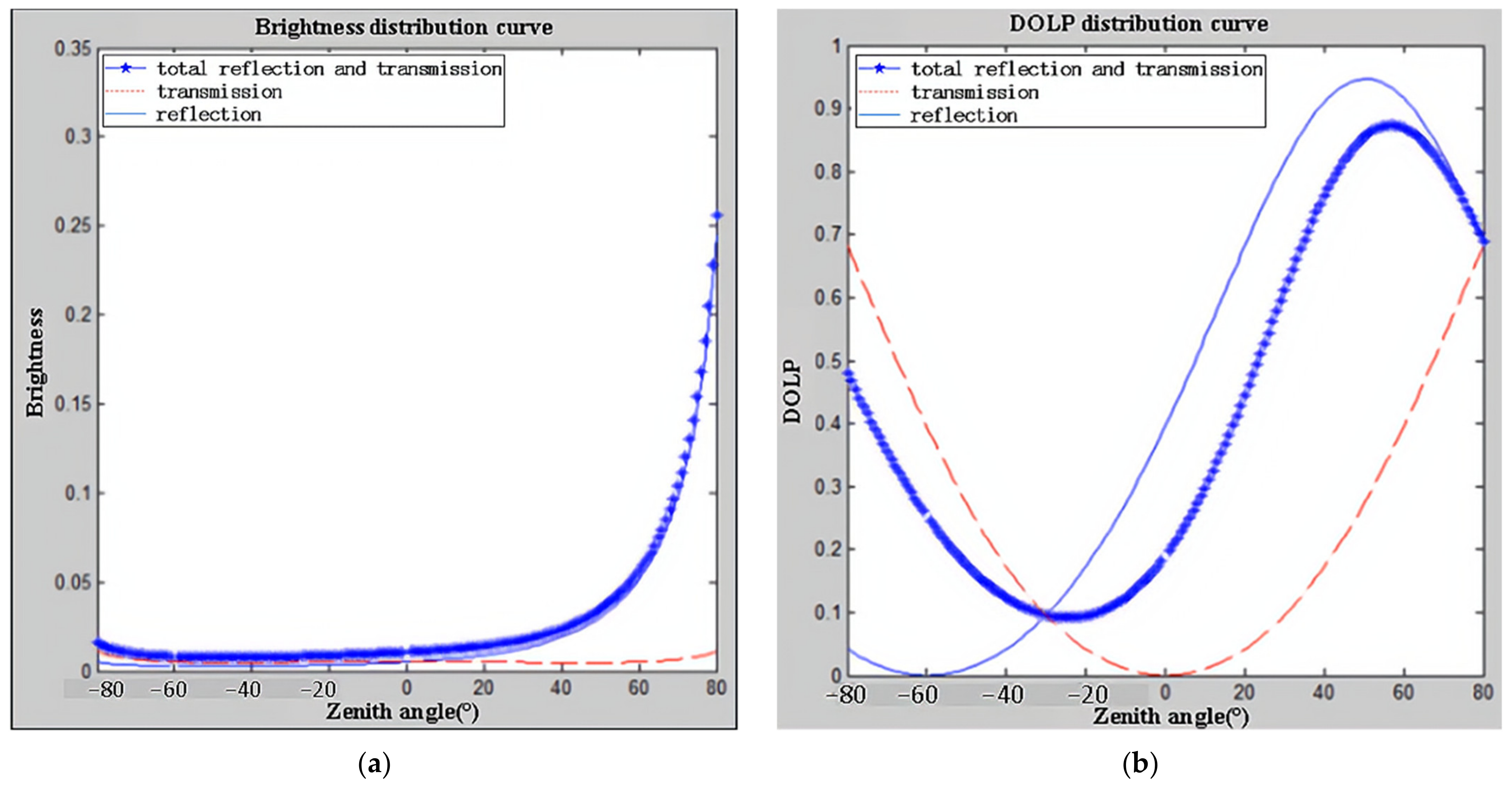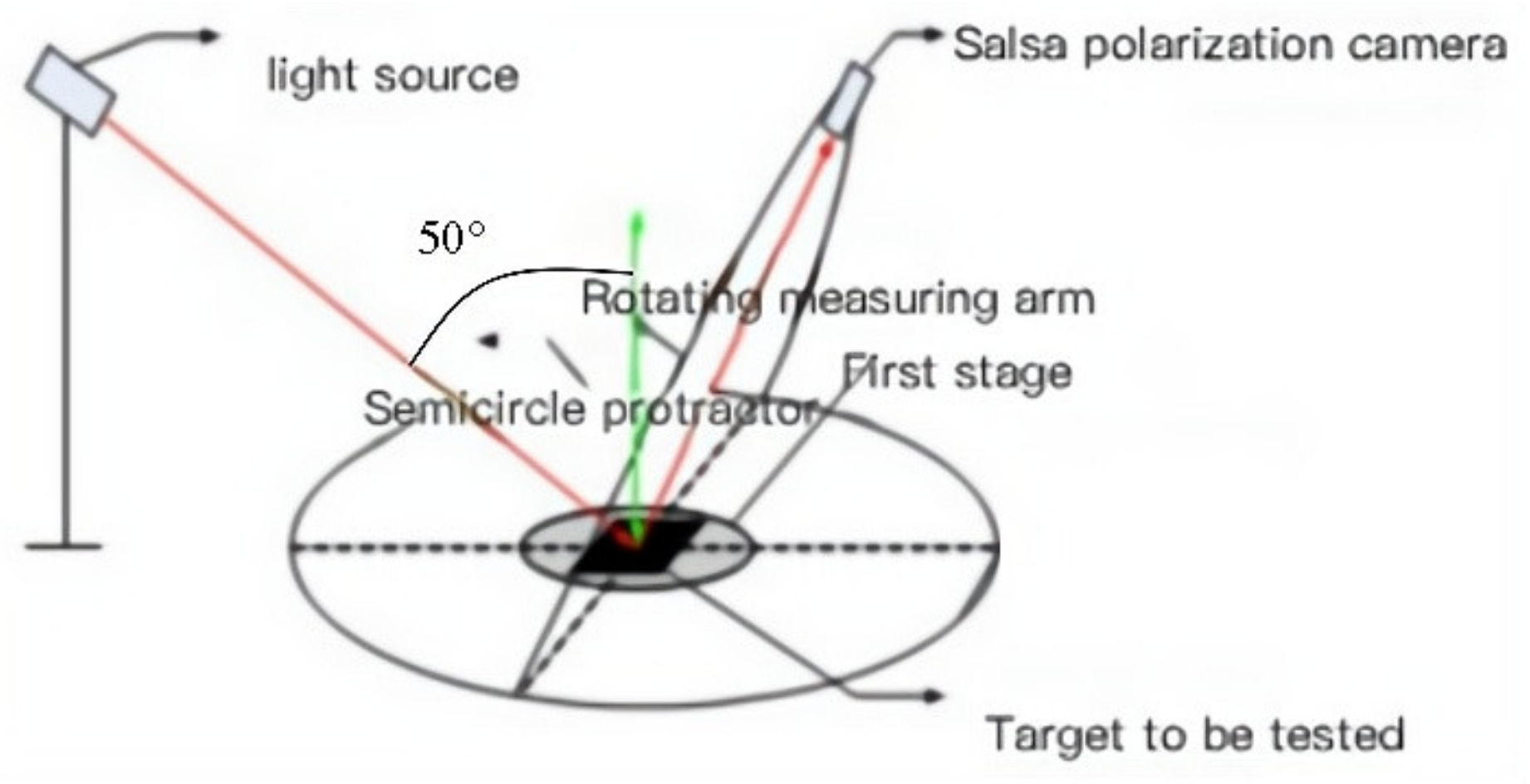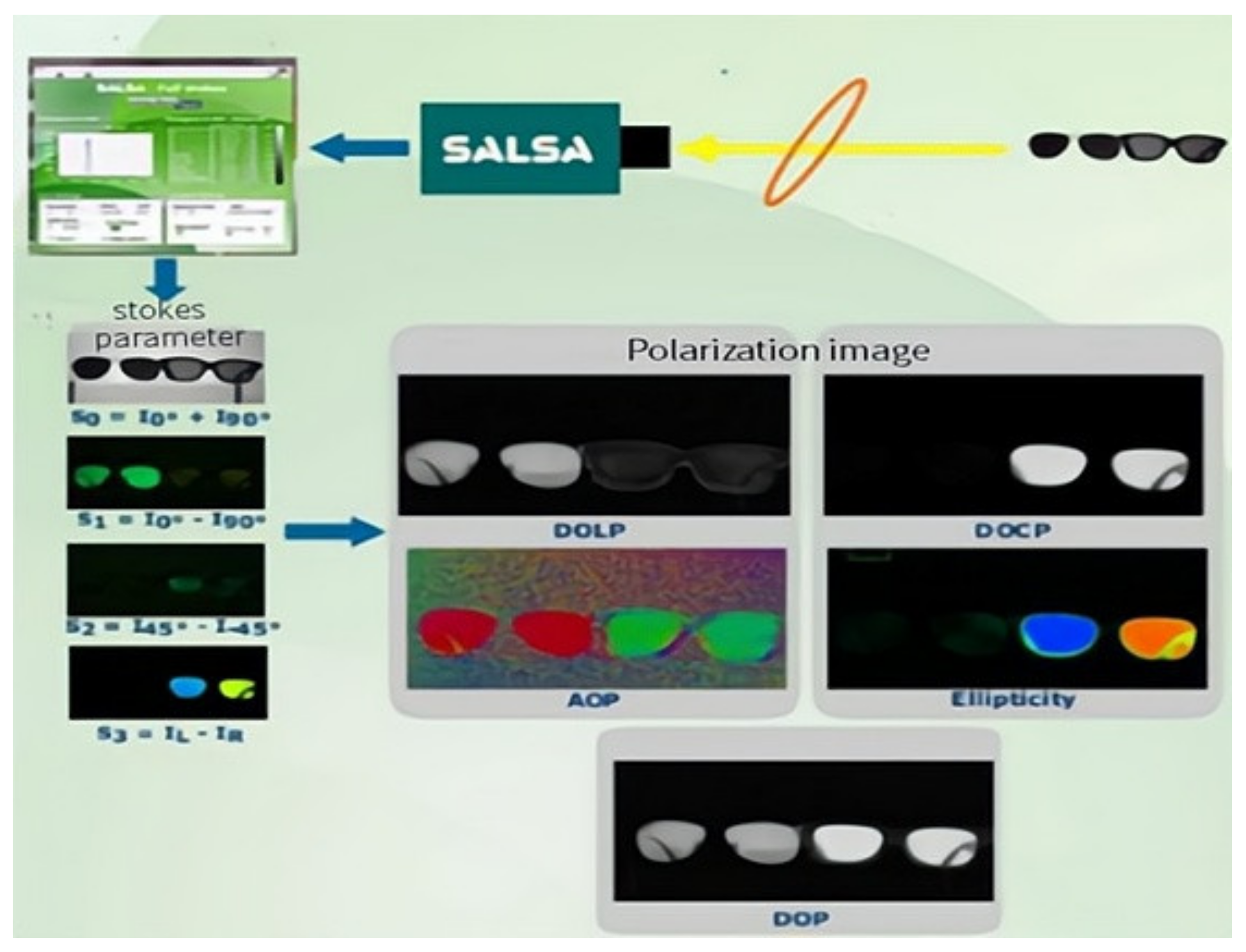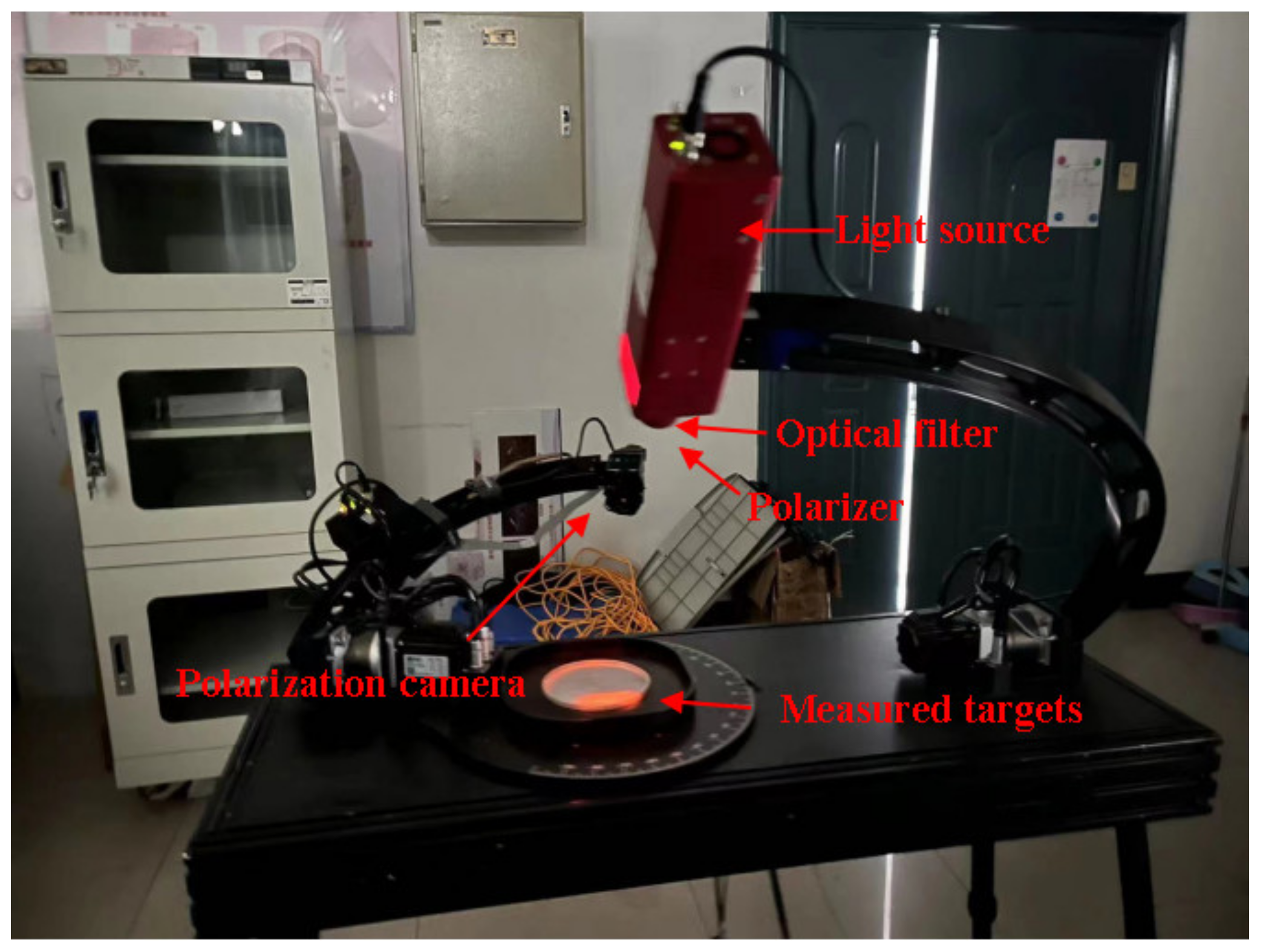2.1. Overview of P-G model
The traditional P-G model is as follows:
where
is any element value in the BRDF matrix of the P-G model polarisation;
is the scattering component, reflecting the energy characteristics of the P-G model, which can be further divided into the diffuse reflection component,
, and bulk scattering component,
;
is the specular reflection component, reflecting the polarisation characteristics of the P-G model, and can be derived from the micro-plane element theory;
is the element of the Mueller matrix;
is the probability distribution function of the micro-plane element normal direction and has Gaussian and Cauchy distributions;
and
are the zenith and azimuth angles in the incident direction, respectively;
and
represent the zenith and azimuth angles in the reflected direction, respectively;
is the wavelength;
is the shading and occlusion function;
is the angle between the specular micro-element normal and material surface normal;
denotes the angle between the incident and outgoing rays;
is the object surface roughness constant; and
is the deviation of the micro-element normal direction from the parameter of the size of the mean normal direction.
The Müller matrix is a function derived from Fresnel’s formula [
15], and the reflected Müller matrix is as follows:
where
is the reflectivity,
is the tangent angle formed by the ratio of the amplitudes of
p and
s waves, and
is the phase difference between the
p and
s waves.
The shading and blocking functions reflect the expression of the incident light-shading and outgoing light-blocking law, owing to the undulation of the rough surface of the material, which is expressed as follows [
16]:
where
τ and Ω are parameters characterising the shadowing and shading effects on rough surfaces; the values obtained are different depending on the material and can be obtained by measurement; and
θ and
β are variables, and the expressions for both are shown below.
where
denotes the angle between the incident and outgoing rays, and
is the angle between the normal of the specular micro-element and that of the material surface.
2.3. The Importance of Model Improvement
The P-G model and its derivative models are usually applicable to materials with a particle size that is larger than the wavelength, such as metals, plastics, and glass. However, for typical coating materials, the particle size is usually between 10 and 100 μm, which is much smaller than the wavelength, and the diffraction effect will occur at this time, so that the propagation path of light will be bent after encountering the object particles in the process of propagation, resulting in random changes in the phase relationship between particles and photons. At this time, it is difficult to describe this part with the P-G model, resulting in reduced model accuracy.
The usual coating materials, such as paint, have low reflectivity and high transmittance. For this kind of material which contains radiation start and high transmittance, the distribution function is a combination of the distribution function of external incident light and a distribution function of positive incident light from inside, and it is difficult for the traditional pBRDF model to accurately simulate this kind of effect.
Coated materials are widely used in various fields, such as spacecraft, military weaponry, medical devices, etc. Therefore, modelling diffraction and transmission effects can improve the fitting and prediction accuracy for such targets.
For most paint targets, such as paints, the surface roughness constants are usually between 0.2 and 0.8, much greater than materials such as metals and glass. Because it is a mixture formed by lipids, pigments, etc., the surface layer of the material is also a mixture of states, which, at the macro level, is rougher. Moreover, because of the process of painting, the paint film is not uniform, there are particles in the environment, and other factors cannot be avoided. Therefore, the surface roughness of the coating material is larger, and its surface undulation is much larger than the wavelength.
2.4. Model Improvement Based on Diffraction Effects
The P-G model is based on a combination of mirrored micro-elements, which need to have a scale much larger than the wavelength, meaning that when the scale of the mirrors is smaller or comparable to the wavelength, the presence of the diffraction effect leads to a random change in the phase relationship between the photons, and this random change in phase leads to a decrease in polarisation.
First, we examined the phase coherence of the light field in the upper hemisphere owing to undulating changes in the surface of the face pattern. Without considering the phase difference because of the physical properties of the material, the phase difference because of the surface pattern is shown in
Figure 2; because the surface of the material has homogeneous characteristics, the three-dimensional case can be replaced by a two-dimensional one.
At any point in the upper hemisphere space is the effect of a phase-coherent superposition of the light intensity of the undulating surface of the material. Without considering the effect of the phase angle because of the angle of the incident and reflected light, the distribution of the intensity in the upper hemisphere space can be seen as a superposition effect per micro-element [
17]; at an observation point
, the phase superposition of the intensity is as follows:
In the pBRDF model, the expression of each effect in the model is the product of the coefficients of that part and the intensity distribution. When the diffraction effect occurs, the intensity distribution on space, that is, the light field distribution (E), is superimposed by each micro-element because the phase relationship between photons changes randomly. Equation (6) corresponds to the light field superposition pattern at a point in space, that is, the intensity distribution. The intensity distribution of the diffraction effect on space can be derived from Equation (6), and then the model component based on the diffraction effect can be deduced.
When the wavelength is 500 nm, the sampling interval is 200 nm, and the maximum peak and valley values of the surface undulation are 50 nm, 500 nm, and 2 μm; the intensity distribution on the near surface is shown in
Figure 3.
As shown in
Figure 3, there is an undulation of the light intensity in the vicinity of the material. As the distance from the surface increases, the effect of the phase difference caused by the surface undulation gradually decreases, and it is mainly the distance that plays a role, not the surface undulation. As the surface undulation gradually increases, the area of light intensity undulation becomes longer, but, in general, the undulation of light intensity tends to be homogeneous once the distance exceeds a certain value.
For coated materials, the surface undulation is much greater than the wavelength. The characterisation of the depolarisation properties is only angle dependent if the surface undulation is similar to the wavelength; therefore, the intensity distribution of the diffraction part, , can be replaced by a constant when modelling.
As shown in
Figure 3, as the surface undulation of the target increases,
gradually converges to 1 because, at sufficiently large surface undulations, the polarisation state of the incident light can be considered to be random with the direction of interaction between the photons and particles within the material; hence, the polarisation state of the incident light is randomly distributed. However, the diffracted light is equally likely to be distributed in all directions throughout space. Therefore, for materials such as paint, for which the surface undulation is much greater than the wavelength, the diffraction effect can be considered a result of having the same intensity in all directions. Thus,
can be defined as follows:
where
is the Mueller matrix element of the diffraction.
2.5. Model Improvement Based on Transmission Effects
It is assumed that, for a specular surface in a specular micro-element assembly, the atoms and molecules within it are undirected and unbiased sources of light, as shown in
Figure 4a. At the surface of the material, the scattered light from all directions is equal at each point, as shown in
Figure 4b. It may be useful to bend the face shape at each point so that the incident light is parallel with respect to the surface normal to the mirror; that is, it is assumed that the mirror is composed of an infinite number of surfaces with circular projections and that there is positive incident light inside, as shown in
Figure 4c. Here, there is a rotation of the transmitted light with respect to the original mirror, with the angle of rotation being equal to the angle of rotation of the mirror. The mirrors were rearranged, considering each projection as a combination of an infinite number of mirrors so that, for the mirrors, the effect of the radiation transmitted from the interior corresponds to the scattering of a set of parallel lights after they have been incident on a convex lens, as shown in
Figure 4d.
Based on the above hypothetical conclusions, the pBRDF of transmitted light can be analysed using the reflection and transmission of the specular micro-element as the primitive. From the Fresnel metric [
16], the polarisation state of the light reflected from a specular micro-element can be expressed as follows:
where
I,
Q,
U, and
V denote the Stokes vectors of the incident and reflected light; the subscript o denotes the incident light;
r denotes the reflected light; and
denotes the Mueller matrix of reflection.
In the case of transmitted light, similar to the reflected light, the polarisation state of the light transmitted by a specular micro-element can be expressed as follows:
where the subscript
r of the observed Stokes vector is also used to represent the transmitted light, as the angle of observation is the same for the transmitted and reflected light; and
represents the Mueller matrix of transmission.
Referring to the general form of the P-G model for specular transmission, we propose the pBTDF model, which can be expressed by the following equation:
Here, the subscript
t denotes transmission (radiation),
I denotes incidence, the incidence angle of 0°, and
r denotes refraction (in the same direction as a reflection in pBRDF). The equivalent incidence angle,
, and mean normal deviation angle,
, in
and
are expressed as follows:
With reference to the general form of the shading functions in the P-G model and the probability distribution function of the surface normal,
and
can be expressed as follows:
Here, the subscript G denotes a Gaussian distribution; the parameters , , and B are constants with different values depending on the material; and is a parameter related to roughness.
We analysed the effects of the transmitted light on pBRDF and pBTDF in terms of both intensity and polarisation.
When the angle of incidence of light is 50°, the light green lacquer coating, for example, has a reflectance of 0.0790 and a complex refractive index of 1.39 + 0.3371i [
18]. Since the effect of transmitted light is considered in this study, the non-specular reflective part is not brought into the model for calculation, and the absorption conversion efficiency of the light green lacquer aluminium plate on the incident light is also not considered; the simulation calculation results are shown in
Figure 5. In
Figure 5, the top graph shows the reflected brightness distribution curve, and the bottom graph shows the polarisation distribution curve. The solid blue line represents the reflection, the dashed red line represents the transmission, and the dotted line represents the total reflection and transmission.
As can be seen from
Figure 5a, owing to the low reflectivity of the green paint, the difference between the brightness of the reflected and transmitted light is smaller when the phase angle is small; as the phase angle increases, the ratio of reflected to transmitted light gradually increases, implying that, at small phase angles, the transmitted light has a greater influence on the overall polarisation characteristics. As can be seen in
Figure 5b, at observation angles less than −40°, the actual DOLP is closer to the DOLP of the transmitted light; however, at observation angles greater than 0°, the DOLP is closer to the DOLP of the reflected light, indicating that the ratio of reflected to transmitted light and the DOLP of the reflected to transmitted light together determine the global DOLP. In addition, the polarisation of the transmitted light also leads to an increase in the DOLP for nonpositive incident light, which is not zero throughout the observed hemispheric space, even when observed at the angle of incidence.
The combined analysis of the transmission effect leads to the following conclusion: modelling of the transmission effect in the visible wavelength band is essentially the modelling of partially, nonspecularly reflected light and can reflect, to some extent, the reasons for the shaping of the nonspecularly reflected component.
2.6. Model Improvement
Combining these two aspects, we propose the following scenario: the paint, at the macroscopic level, can be considered a homogeneous mixture with a structural scale much larger than the wavelength so that the intensity distribution of its diffractive part tends to be homogeneous. The transmitted part has a high weight in the visible range, and together with the reflected part, it determines global polarisation. Therefore, the improved model consisted of two main components: a specular-reflecting component and a transmitting component.
2.6.1. Specular Reflection
First, the specular micro-elements should have a compound-symmetric distribution when studying single-particle scattering. The Cauchy distribution was not symmetrical; thus, it was not considered. If we use a Gaussian distribution, there is a problem of low peaks and troughs. The approximate description of the particle scattering phase function is referred to as the Hermite–Gaussian (H-G) phase function [
19], which is used to describe the asymmetry of the light intensity in the forward–backwards intensity distribution. Therefore, this H-G phase function is used to describe the specular micro-element normal distribution of the material surface, whereupon, for the specular reflection,
where
is the surface normal probability distribution of the specular micro-element, which is expressed as
Here,
is the asymmetry factor.
2.6.2. Transmission
Having mentioned the general form of the probability distribution function for the transmission component in the previous section, the phase function for the transmission component, after describing it in terms of the H-G phase function, is as follows:
Here,
is the surface normal probability distribution of the transmission effect as follows:
where
is the asymmetry factor in transmission.
2.6.3. Model Synthesis
Combining the above studies, we need to model not only the reflected light component but also the transmitted and diffracted light components based on the P-G model; therefore, based on the P-G model, our proposed new pBTDF model is described in terms of both intensity and DOLP, and the improved model is as follows.
For the intensity section:
The improved model based on transmission and diffraction effects mainly consists of three parts, namely specular reflection, transmission, and diffraction, which are treated separately in the study to obtain the expressions for the intensity part of the pBTDF model as follows:
where
,
, and
denote the coefficients of the specular reflection, transmission, and diffraction components, respectively.
By substituting Equations (7), (16), and (18) into Equation (20), respectively, we obtain the following:
For the DOLP section:
Because the Mueller matrix is a 4 × 4 matrix, but the circular polarisation component is small and usually neglected in the study of polarisation properties, the incident light and pBTDF matrix can be downscaled after neglecting the circular polarisation component. Therefore, Equation (21) can be converted into a 3 × 3 matrix form with the following expression:
In the case where the incident light is 0° linearly polarised, the incident light is expressed in terms of the Stokes vector, and the reflected light Stokes vector is obtained with the following expression:
Then, its simplified expression for DOLP is as follows:
By writing Equation (25) in Mueller’s form, the expression of Equation (24) becomes the following:
By substituting the elements of the Müller matrix into Equation (25), the expression for the DOLP part of the pBTDF model is obtained as follows:
Here, η is the scale factor of the polarisation.
2.7. Experimental Verification
Equation (26) indicates that the DOLP is a multivariate nonlinear correlation function between the complex refractive index, reflected scattering component, and detection angle. The inversion of the five parameters,
n,
k,
,
, and
, of the target was performed using nonlinear least squares. An objective function was established, and the minimum standard deviation of the experimental measurements and model simulations was used as the best criterion for determining the model parameters [
20], using the following expression:
where
is the simulated value of the model, and
is the experimental value obtained from the measurement.
To obtain the actual measurement values, an experimental scheme for evaluating the polarisation characteristics of indoor target surfaces was designed, and an experimental setup was built to obtain the polarisation images of the targets of different materials at different angles. The experimental system for polarisation characteristic testing included three parts: an active illumination device, a polarisation characteristic testing device, and an information-processing device. A schematic of the experimental setup is shown in
Figure 6.
The polarised light active illumination unit consists of a tripod, light source, polariser, and filters. The light source and polariser were placed on a tripod and aligned along the same optical axis. The polarisation characteristic test device was a SALSA polarisation camera, which controlled the detection angle and distance. The information-processing device consisted of a controller and a computer. The general idea of the experiment is that the light source passes through the polariser and becomes fully linearly polarised and then hits the target surface, where scattering occurs. The polarisation camera receives the information in real time and passes it to the controller, where the data are saved and calculated using a laptop.
The controller connects the information acquisition device to the information-processing device and has interfaces on the sides of the camera and computer. The information-processing device can synthesise images acquired using a polarisation camera to obtain the desired polarisation images and calculate the DOLP data. In the experimental verification, the polarisation image acquired using the above method and the calculated DOLP were used as the actual measurement data. A schematic of the DOLP acquisition process is presented in
Figure 7 [
12].
Because the improved model based on diffraction and transmission effects is based on the special properties of common artefacts such as paint, those effects are modelled. To verify the accuracy of the improved model, this experiment chose an aluminium plate as the substrate, and the coatings were chosen from light green, dark green, and earth yellow paints with a thickness of 0.2 mm, which visible light cannot penetrate; so, it can be considered the polarisation property of the paint surface. Different light wavelengths affect the DOLP [
21]. Therefore, to avoid the effect of different wavelengths of light on the experimental results, we added a green filter in front of the SALSA camera lens with a central wavelength of 532 nm, allowing only green light waves to pass through and limiting the light’s wavelength range. Polarisation images were acquired as follows:
Step 1: We placed the test sample in the centre and rotated the polariser to 0° so that the light source received 0° line-polarised light through the polariser.
Step 2: We set the zenith angle of detection normal to the target surface to 0°. Using this normal as a boundary, we set the detection zenith angle on the same side as the light-source emission direction to negative, and then we set the detection zenith angle on the different side to positive. We rotated the rotation arm on the zenith two-dimensional turntable to the −90° scale and increased the zenith angle by 2° each time until it moved from the −90° to 90° semicircle to complete the corresponding polarisation image acquisition.
Step 3: We added filters with different centre bands in front of the light source and repeated Steps 1 and 2 to acquire the polarisation information of the polarised image.
Step 4: We synthesised the captured polarisation images, using the controller to obtain the DOLP images and determine the corresponding DOLP as the actual measurement data of the DOLP.
The built experimental setup and data-acquisition site are shown in
Figure 8.
